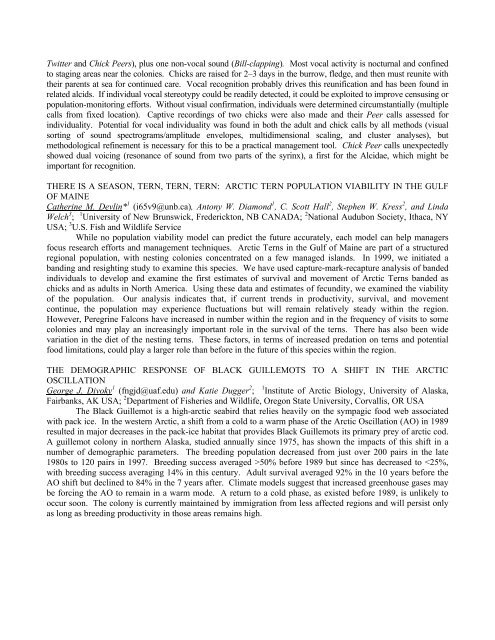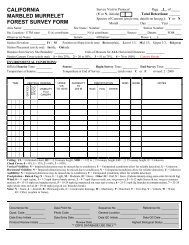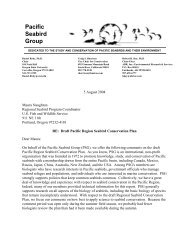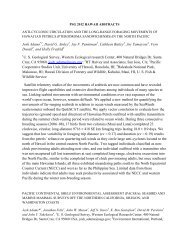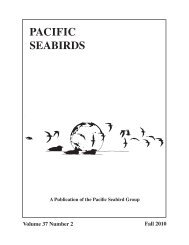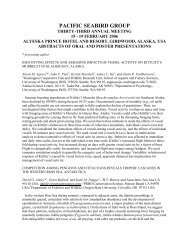abstracts of oral and poster presentations - Pacific Seabird Group
abstracts of oral and poster presentations - Pacific Seabird Group
abstracts of oral and poster presentations - Pacific Seabird Group
You also want an ePaper? Increase the reach of your titles
YUMPU automatically turns print PDFs into web optimized ePapers that Google loves.
Twitter <strong>and</strong> Chick Peers), plus one non-vocal sound (Bill-clapping). Most vocal activity is nocturnal <strong>and</strong> confined<br />
to staging areas near the colonies. Chicks are raised for 2–3 days in the burrow, fledge, <strong>and</strong> then must reunite with<br />
their parents at sea for continued care. Vocal recognition probably drives this reunification <strong>and</strong> has been found in<br />
related alcids. If individual vocal stereotypy could be readily detected, it could be exploited to improve censusing or<br />
population-monitoring efforts. Without visual confirmation, individuals were determined circumstantially (multiple<br />
calls from fixed location). Captive recordings <strong>of</strong> two chicks were also made <strong>and</strong> their Peer calls assessed for<br />
individuality. Potential for vocal individuality was found in both the adult <strong>and</strong> chick calls by all methods (visual<br />
sorting <strong>of</strong> sound spectrograms/amplitude envelopes, multidimensional scaling, <strong>and</strong> cluster analyses), but<br />
methodological refinement is necessary for this to be a practical management tool. Chick Peer calls unexpectedly<br />
showed dual voicing (resonance <strong>of</strong> sound from two parts <strong>of</strong> the syrinx), a first for the Alcidae, which might be<br />
important for recognition.<br />
THERE IS A SEASON, TERN, TERN, TERN: ARCTIC TERN POPULATION VIABILITY IN THE GULF<br />
OF MAINE<br />
Catherine M. Devlin* 1 (i65v9@unb.ca), Antony W. Diamond 1 , C. Scott Hall 2 , Stephen W. Kress 2 , <strong>and</strong> Linda<br />
Welch 3 ; 1 University <strong>of</strong> New Brunswick, Frederickton, NB CANADA; 2 National Audubon Society, Ithaca, NY<br />
USA; 3 U.S. Fish <strong>and</strong> Wildlife Service<br />
While no population viability model can predict the future accurately, each model can help managers<br />
focus research efforts <strong>and</strong> management techniques. Arctic Terns in the Gulf <strong>of</strong> Maine are part <strong>of</strong> a structured<br />
regional population, with nesting colonies concentrated on a few managed isl<strong>and</strong>s. In 1999, we initiated a<br />
b<strong>and</strong>ing <strong>and</strong> resighting study to examine this species. We have used capture-mark-recapture analysis <strong>of</strong> b<strong>and</strong>ed<br />
individuals to develop <strong>and</strong> examine the first estimates <strong>of</strong> survival <strong>and</strong> movement <strong>of</strong> Arctic Terns b<strong>and</strong>ed as<br />
chicks <strong>and</strong> as adults in North America. Using these data <strong>and</strong> estimates <strong>of</strong> fecundity, we examined the viability<br />
<strong>of</strong> the population. Our analysis indicates that, if current trends in productivity, survival, <strong>and</strong> movement<br />
continue, the population may experience fluctuations but will remain relatively steady within the region.<br />
However, Peregrine Falcons have increased in number within the region <strong>and</strong> in the frequency <strong>of</strong> visits to some<br />
colonies <strong>and</strong> may play an increasingly important role in the survival <strong>of</strong> the terns. There has also been wide<br />
variation in the diet <strong>of</strong> the nesting terns. These factors, in terms <strong>of</strong> increased predation on terns <strong>and</strong> potential<br />
food limitations, could play a larger role than before in the future <strong>of</strong> this species within the region.<br />
THE DEMOGRAPHIC RESPONSE OF BLACK GUILLEMOTS TO A SHIFT IN THE ARCTIC<br />
OSCILLATION<br />
George J. Divoky 1 (fngjd@uaf.edu) <strong>and</strong> Katie Dugger 2 ; 1 Institute <strong>of</strong> Arctic Biology, University <strong>of</strong> Alaska,<br />
Fairbanks, AK USA; 2 Department <strong>of</strong> Fisheries <strong>and</strong> Wildlife, Oregon State University, Corvallis, OR USA<br />
The Black Guillemot is a high-arctic seabird that relies heavily on the sympagic food web associated<br />
with pack ice. In the western Arctic, a shift from a cold to a warm phase <strong>of</strong> the Arctic Oscillation (AO) in 1989<br />
resulted in major decreases in the pack-ice habitat that provides Black Guillemots its primary prey <strong>of</strong> arctic cod.<br />
A guillemot colony in northern Alaska, studied annually since 1975, has shown the impacts <strong>of</strong> this shift in a<br />
number <strong>of</strong> demographic parameters. The breeding population decreased from just over 200 pairs in the late<br />
1980s to 120 pairs in 1997. Breeding success averaged >50% before 1989 but since has decreased to


